Tarp Glossary

Agricultural Tarp
Tarps used for agricultural applications, such as covering crops, hay bales, or farm equipment, that help provide protection against weather elements, or to preserve moisture.
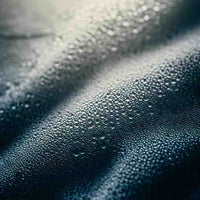
Anti-condensation coating
A coating applied to the underside of a tarp to prevent the buildup of condensation and moisture.

Anti-UV Coating
A coating applied to a tarp to enhance its resistance to ultraviolet (UV) rays, prolonging its lifespan and preventing color fading.
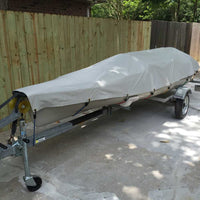
Boat cover
A specialized tarpaulin designed to cover and protect boats or watercraft when not in use, shielding them from rain, UV rays, or debris.
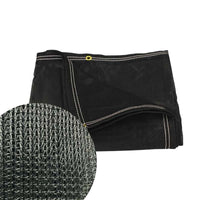
Breathability
The ability of a tarp to allow air circulation, reducing condensation and preventing the buildup of moisture.

Breathable membrane
A type material that allows moisture vapor to escape while preventing water from entering.

Bungee cord
Elastic cords with hooks or fasteners on each end, commonly used to secure tarps tightly by attaching to grommets or anchor points, maintaining tension and stability.

Camouflage tarp
A tarp with a camouflage pattern, often used in outdoor activities such as hunting, military operations, or wildlife photography to blend in with the surroundings.

Camping tarp
A versatile tarp used for various camping purposes, such as creating a shelter, providing shade, or protecting gear from rain or sun.
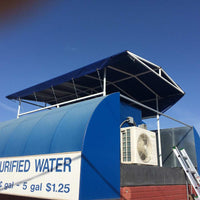
Canopy
A type of tarpaulin used as a cover or roof-like structure, often supported by poles or a frame, to provide shade or shelter in outdoor events, markets, or recreational areas.
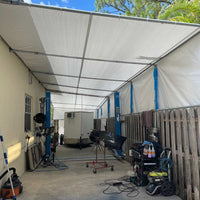
Canopy tarp
A decorative or functional overhead covering created using a tarp, commonly used for outdoor parties, weddings, or events to provide shade and protect against light rain.
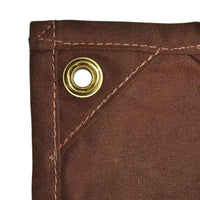
Canvas
A heavy-duty, woven fabric made from cotton, polyester, or a blend of both, often used in the production of tarps for their strength and durability.
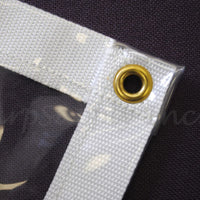
Clear tarp
A transparent or translucent tarpaulin that allows light to pass through while still providing protection, often used for greenhouse coverings, outdoor enclosures, or temporary windows.

Coating
A protective layer applied to a tarp to enhance its water resistance, UV resistance, or other properties.

D-Rings
Metal rings shaped like the letter "D" that are attached to a tarp to provide secure tie-down points.

Debris containment tarp
A heavy-duty tarp used to contain and cover debris, rubble, or construction materials during demolition, renovation, or cleanup operations.
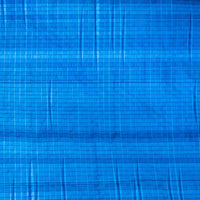
Denier
A unit of measurement that indicates the fineness or thickness of a fiber used in tarps.
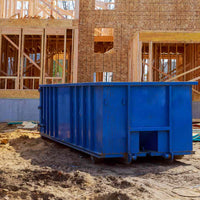
Dumpster cover tarp
A tarp used to cover dumpsters or waste containers, preventing odors, containing debris, and deterring unauthorized access or scavenging.

Dust cover tarp
A lightweight tarp used to protect furniture, machinery, or equipment from dust, dirt, or debris during storage or renovation.
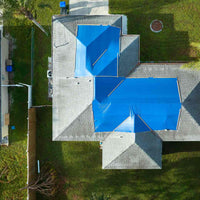
Emergency tarp
A compact, lightweight tarpaulin intended for emergency or survival situations, often included in disaster preparedness kits, camping gear, or vehicle emergency supplies.

Eyelet
A small hole in a tarp through which a rope or hook can be inserted for fastening or securing.

Flame Retardant
Tarps treated with special chemicals or coatings to inhibit the spread of flames or resist burning when exposed to fire or high heat.

FR (Flame retardant) certification
A certification indicating that a tarp meets specific flame resistance standards.
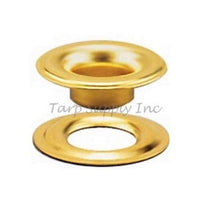
Grommet
A reinforced eyelet or metal ring embedded along the edges of a tarp, used for securing the tarp with ropes, bungee cords, or hooks.

Groundsheet
A tarp used as a protective layer between the ground and a tent or camping equipment to prevent moisture, dirt, or damage.

Hay tarp
A tarp specifically designed to protect hay or straw from moisture, UV rays, and other environmental factors that could compromise its quality or nutritional value.

Heavy-duty
A term used to describe tarps that are designed for more demanding applications, characterized by thicker material, reinforced construction, and higher weight capacity.
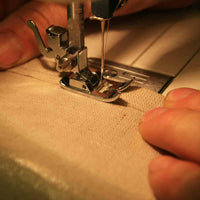
Hem
The folded and stitched edge of a tarp that provides reinforcement and prevents fraying.
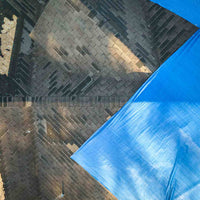
Hurricane tarp
A heavy-duty tarp used as a temporary roof cover or emergency shelter during and after a hurricane or severe storm, providing temporary protection until permanent repairs can be made.
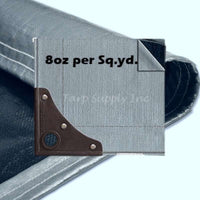
Industrial tarp
Tarps engineered for heavy-duty industrial applications, such as construction sites, warehouses, or transportation, providing protection for equipment, materials, or open spaces.
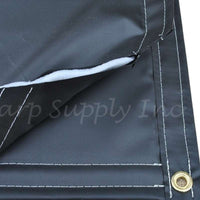
Insulated tarp
A tarp with built-in insulation, usually in the form of foam or bubble wrap, to provide additional temperature regulation and thermal protection.
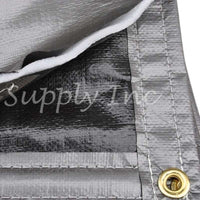
Insulated tarp cover
A removable cover made of insulated tarp material, often used to wrap and insulate large containers, tanks, or machinery, maintaining temperature or preventing condensation.
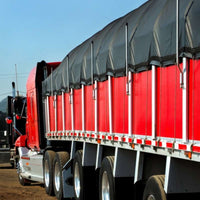
Insulated truck tarp
A specialized tarpaulin designed for refrigerated or temperature-controlled trucks, featuring insulation layers to maintain the desired temperature for perishable cargo.
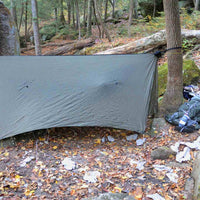
Laminated tarp
A tarpaulin made by bonding multiple layers of material together, typically with a central layer of woven fabric sandwiched between layers of coating or film, providing increased strength and water resistance.

Lumber tarp
A large tarp specifically designed for covering and protecting stacks of lumber during transportation, often equipped with flaps, pockets, or straps for secure containment.
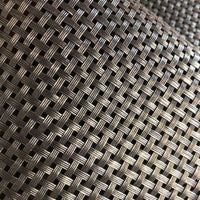
Mesh tarp
A tarpaulin constructed with an open-weave mesh fabric, allowing air and some light to pass through while still providing coverage and protection.

Mildew-resistant
It refers to the ability to resist the growth of mildew, which is a type of fungus that thrives in damp and humid conditions. Mildew can cause unsightly stains, odors, and deterioration of the tarp material
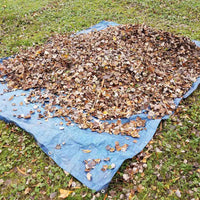
Multi-purpose tarp
A tarpaulin designed to serve multiple applications and uses, offering flexibility and adaptability in different situations.

Polyethylene
A thermoplastic polymer commonly used in tarpaulins due to its durability, water resistance, and cost-effectiveness.

Polyethylene terephthalate (PET)
A strong and lightweight polymer commonly used in the production of clear tarps and greenhouse coverings.
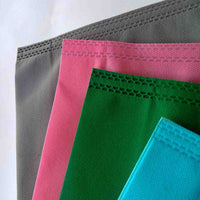
Polypropylene
A thermoplastic polymer used for making lightweight and flexible tarps, known for its resistance to chemicals and sunlight.
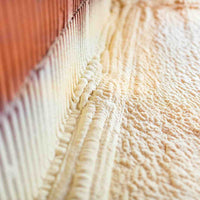
Polyurethane
A versatile polymer used in tarp manufacturing, providing durability, flexibility, and resistance to weathering.

Pond liner
A tarp or membrane used to create a watertight barrier when constructing or lining ponds, reservoirs, or water features, preventing water seepage and soil erosion.

Pond tarp repair kit
A collection of materials and tools used for fixing tears, punctures, or leaks in pond liners or tarps used for water containment, ensuring water integrity.

Privacy tarp
A tarp used to create privacy screens or barriers, often seen in construction sites, events, or temporary structures to shield specific areas from public view.
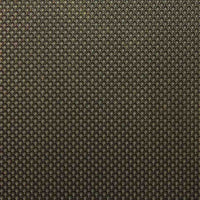
PVC (Polyvinyl chloride)
A type of plastic often used for heavy-duty tarps due to its high strength and durability.

Reinforced corners
Tarps with reinforced corners have additional layers or patches of material at the corners to provide extra strength and durability, as these areas are more prone to wear and tear.
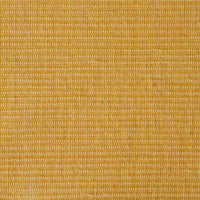
Ripstop fabric
A type of fabric, often used in tarps, with reinforcing threads woven into a grid pattern, making it resistant to tearing and preventing a small tear from spreading further.

Ripstop nylon
A lightweight and tear-resistant fabric used for making tarps, often used in camping and outdoor applications.
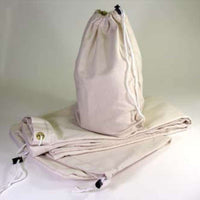
Storage bag
A storage or carrying bag specifically designed to hold and protect tarps when not in use, facilitating transportation and organization.

Taffeta
A smooth and shiny fabric used for making lightweight and packable tarps, often used in backpacking and travel.
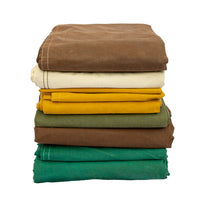
Tarp or tarpaulin
A tarp, short for tarpaulin, is a large sheet of strong, flexible material, often made of canvas or polyethylene, used to provide protection or cover from the elements.

Tarp repair kit
A collection of tools, adhesives, and materials designed for on-the-spot repairs of tarps, allowing users to fix small tears, grommets, or seams quickly.

Tarp seam reinforcement
The strengthening of tarp seams through stitching, heat-sealing, or the addition of reinforcement strips, increasing durability and resistance to tearing.
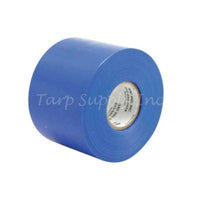
Tarp tape
A specialized adhesive tape designed for repairing or reinforcing tarps, providing a temporary or permanent solution for small tears or holes.

Tarp tensioner
A device or accessory used to tighten and secure a tarp, preventing flapping, sagging, or loosening caused by wind or movement.
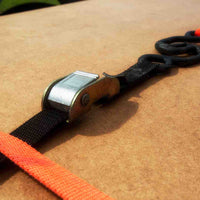
Tarp tie-downs
Straps or ropes used to secure a tarp in place, preventing it from being blown away by wind or other forces.

Tarpaulin abrasion resistance
The ability of a tarp to withstand rubbing, scraping, or friction without sustaining significant damage or wear, ensuring longevity and reliability.

Tarpaulin adhesive
A strong, waterproof adhesive designed for bonding tarps together, repairing tears, or attaching accessories to tarps, providing a durable and long-lasting hold.

Tarpaulin anchor kit
A set of accessories, such as stakes, anchors, or straps, used to secure a tarp to the ground, ensuring stability and preventing movement or displacement.

Tarpaulin anchor point
A designated attachment point on a tarp where ropes, cords, hooks, or bungee cords can be secured, allowing for proper tensioning and securement.

Tarpaulin awning
A retractable or fixed cover made of tarp material, commonly used for shading windows, patios, or outdoor areas, providing protection from sun and rain.
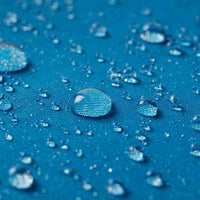
Tarpaulin chemical resistance
The ability of a tarp to resist damage or degradation when exposed to chemicals, solvents, oils, or corrosive substances, ensuring durability and longevity.
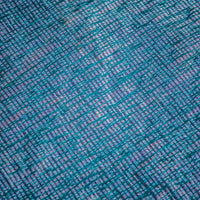
Tarpaulin colorfastness
The resistance of a tarp to fading or discoloration when exposed to sunlight or other environmental factors, ensuring long-lasting color vibrancy.

Tarpaulin condensation prevention
Measures or features incorporated into tarps to minimize condensation buildups, such as breathable materials, vents, or insulation, preventing moisture-related issues.

Tarpaulin flame resistance
The ability of a tarp to resist ignition, burning, or the spread of flames, often achieved through fire-retardant treatments or materials.

Tarpaulin heat welding
A process that utilizes heat and pressure to fuse or weld tarps together, creating a strong, permanent bond at seams or joins.

Tarpaulin load cover
A tarp specifically designed for covering and securing loads on trucks, trailers, or flatbeds during transportation, ensuring cargo protection and safety.

Tarpaulin printer
A specialized printer capable of printing large-format graphics, text, or designs directly onto tarps, commonly used for advertising, signage, or branding purposes.

Tarpaulin seam sealer
A specialized adhesive or sealant used to reinforce or repair seams in tarps, ensuring water resistance and preventing leakage at these vulnerable points.

Tarpaulin shrinkage
The contraction or reduction in size that can occur when a tarp is exposed to heat, causing it to become smaller than its original dimensions.
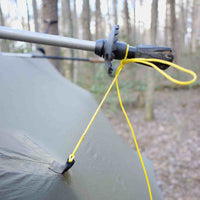
Tarpaulin suspension system
A set of hooks, ropes, or bungee cords used to suspend a tarp from overhead structures, facilitating easy installation and adjustment.

Tarpaulin thickness
A measurement indicating the thickness or gauge of the material used in a tarp, influencing its strength, durability, and weight capacity.

Tarpaulin thickness gauge
A measuring tool or device used to determine the thickness or gauge of tarpaulin material, aiding in quality control and specification compliance.

Tarpaulin-enclosed structure
A temporary or semi-permanent structure constructed using tarps as walls, roofing, or partitions, providing shelter or privacy in outdoor settings.

Tear-resistant
Tarps that are tear-resistant have enhanced strength and durability, making them less prone to tearing or ripping under stress or harsh conditions.

Tensile strength
The maximum amount of force or tension a tarp can withstand before breaking or tearing.

Tent shelter
A makeshift shelter constructed using a tarp and supporting poles, ropes, or trees, providing protection from rain, wind, or sun in outdoor settings.

Thermal insulation
A property of certain tarps that helps regulate temperature by reducing heat transfer, keeping the covered area cooler or warmer.

Truck tarp
A specialized tarp designed to cover and secure cargo on a truck bed, often equipped with features such as tie-down straps, buckles, or fasteners for proper load containment.
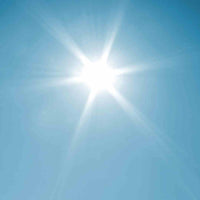
UV-resistant
Tarps that are UV-resistant are designed to withstand prolonged exposure to ultraviolet (UV) rays from the sun without significant degradation or fading.
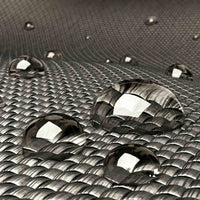
Waterproof
Refers to the ability of a tarp to repel water and prevent it from passing through, keeping the covered area dry.

Wind-resistant tarp
Tarps engineered to withstand high winds or gusts, often featuring reinforced edges, additional tie-down points, or aerodynamic designs to minimize flapping and damage.